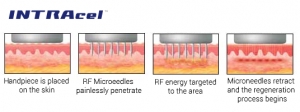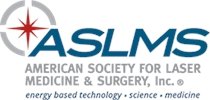Intracel RF Microneedling in Washington, DC
What is Radiofrequency (RF) Microneedling?
RF Microneedling is the controlled delivery of heat energy to the layer of skin called the dermis, where collagen and elastin reside. The Intracel RF Microneedling device utilizes ultrafine insulated needles in a 9×9 grid. Insulated needles enable the delivery of RF heat energy only at the tip of the needle, while the insulated part of the needle passing through overlying layers of skin does not deliver heat energy, protecting the epidermis from unnecessary damage.

How is Intracel RF Microneedling different from other forms of Microneedling?
A Brief History of Microneedling:
1st Generation: Rollers with Needles Passed Over Skin
2nd Generation: Motorized Microneedle ‘Pens’
3rd Generation: Radiofrequency Devices with Non-Insulated Needles
4th Generation: Intracel Radiofrequency Microneedling with Insulated Needles
Microneedling is the delivery of discrete wounds to skin using microneedles applied through various methods. The small areas of trauma caused by the microneedles undergo regeneration and growth factor release, leading to generalized improvements of skin tone and texture. Early devices such as rollers required nearly daily treatments for minimal improvement and have fallen out of favor. Second generation devices such as microneedling pens employ a motor to rapidly insert and remove a small grid of microneedles into the skin at preset depths. These microneedling pens provide modest improvements to skin tone and texture over time, yet are used primarily to create micropores in the skin for topical medication delivery. Third generation devices added RF energy to the microneedling process. While this is similar to the Intracel Device, the 3rd generation devices utilized non-insulated needles, meaning the entire needle, from tip to base, delivered heat to the tissue it was in contact with, including the superficial layers of skin (epidermis). Unfortunately, the amount of heat needed to stimulate collagen and growth in the dermis can cause severe damage to the epidermis, which resulted in permanent scarring, ‘track lines’, enlarged pores, and post-treatment hypo and hyperpigmentation of skin with these devices. 4th generation devices, such as the Intracel, utilize insulated needles in a 9×9 pattern (49 needles total) in a solenoid controlled stamping device. The insulated needles only deliver heat energy to the tip of the needle. This device provides a combination of fractionated epidermal skin punctures similar to traditional microneedling resulting in tone and texture improvements, as well as the controlled delivery of RF heat energy to lower layers of skin, stimulating collagen production and a significant reduction in pore size, wrinkles, and fine lines, crepe skin, as well as skin tightening of the face, neck, and jowls.
How is Intracel RF Microneedling Different from Fractional Laser Treatment and other RF Skin Tightening Devices?
Introduced over a decade ago, non-ablative fractional laser treatments such as Fraxel were revolutionary in the treatment of fine lines, enlarged pores, and superficial skin irregularities. Unfortunately, Fraxel and other non-ablative fractional lasers can deliver energy very well to the surface and very upper layers of skin, but energy dissipates completely before reaching the mid-dermis, where most of our collagen and elastin, the supporting structures in our skin, reside. This results in little to no skin tightening effect and a failure to improve deep wrinkles and lines. Ablative Fractional lasers (CO2) on the other hand are able to deliver energy deeply into the skin, but do so at the expense of the overlying skin, which is vaporized, leading of downtime while the overlying skin regenerates itself. Intracel produces similar injury to the superficial skin to allow for regenerative improvement in tone and texture of skin, but also delivers energy to the mid-dermis, causing neocollagenesis (new collagen formation) for a mild lifting effect and correction of mild surface irregularities such as fine lines and wrinkles.
Non-invasive RF treatment devices such as Thermage attempt to heat deeper layers of skin by passing RF energy through the skin while simultaneously cooling for protection. While this treatment was popular over a decade ago, significant patient discomfort and highly inconsistent results led us to discontinue offering this procedure. With advancing technology such as Intracel RF microneedling we are now able to achieve consistent, reproducible, and long-lasting results that previous RF devices were not able to achieve.
Is Intracel RF Microneedling Painful?
RF Microneedling is normally well tolerated. We offer a topical numbing cream to reduce discomfort. Unlike other RF Microneedling devices such as Infini, Vivace, and Profound, Intracel can deliver both monopolar and bipolar RF energy. Monopolar energy, which radiates downward and not between the needles, leads to significantly less discomfort with higher energy delivery than bipolar only devices. Only the Intracel device offers both monopolar and bipolar capability. Often, both will be utilized in one treatment for synergistic effects at various treatment depths.
How many treatments are required and how long until I will see results?
Depending on the condition of the skin in the area being treated, we generally recommend an initial series of 4 treatments, with the average being 3 treatments spaced 4-6 weeks apart. Improvement in tone and texture are seen in the weeks to months following each treatment. Fine line and wrinkle reduction are generally seen between 3-6 months after each treatment, due to the long healing process of subcutaneous tissues and generation of new collagen.
How much downtime is associated with Intracel RF Microneedling?
Post-treatment, patients generally experience 1-2 days of redness and dryness of skin. Makeup can be applied starting 24 hours after treatment. A comprehensive post-treatment skincare regimen will be discussed to maximize results.





